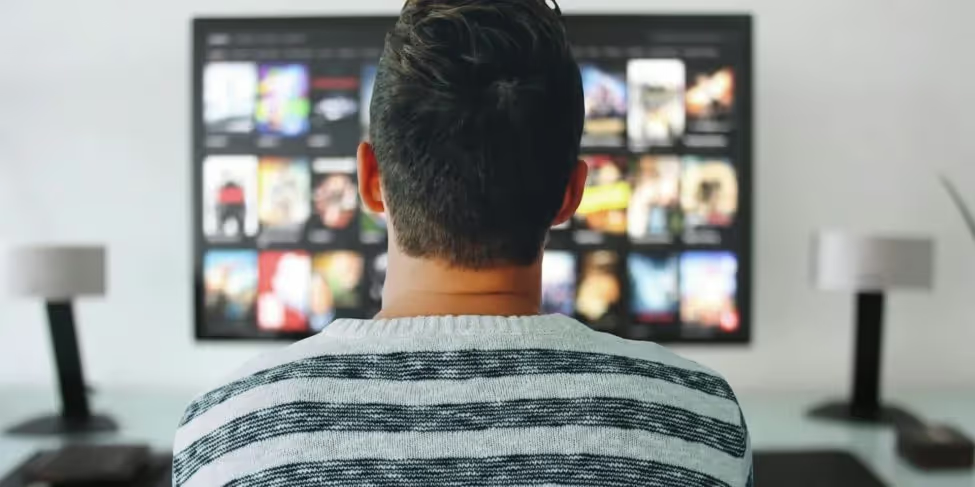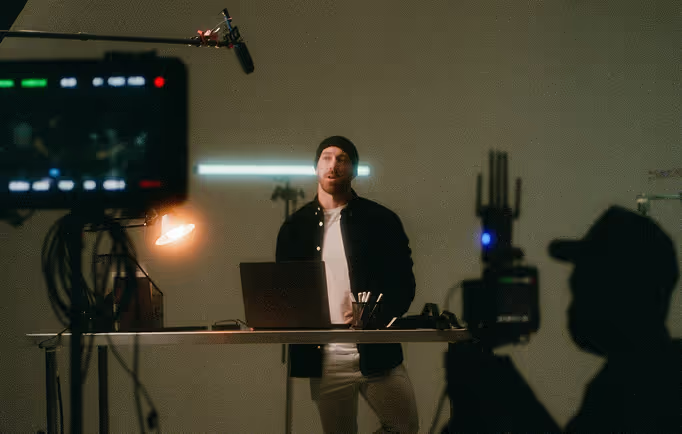The philosophy behind why we watch videos

Humans. Can’t live with ’em, can’t live without ’em, can’t read this blog without being one (hyper-intelligent dolphins aside). We’re a weird animal who finds meaning in pondering our own existence, and joy in watching unreal events display to us on very large or very tiny boxes of metal and wires. But why do we love to watch videos with an almost voyeuristic enrapturement, and what joy do we get from seeing stories unfold that we have no part in?
By understanding the philosophy behind why we watch videos we can better cater to those deeper needs with our own video content.
1) “we demand windows”
It’s difficult to answer why we like watching movies without understanding why we like art, and fiction, in the first place.
“We want to be more than ourselves,” is how author C.S. Lewis discussed our human love for fiction. “Each of us by nature sees the whole world from one point of view with a perspective and a selectiveness peculiar to himself… [But] we want to see with other eyes, to imagine with other imaginations, to feel with other hearts, as well as with our own… We demand windows. One of the things we feel after reading a great work is ‘I have got out’. Or from another point of view, ‘I have got in’; pierced the shell of some other monad and discovered what it is like inside.”
The idea of ‘getting out’ of our own consciousness through art is a powerful one, because it suggests that videos and other media have the power to broaden our perspective and inherently make us more loving, or at least more understanding, human beings. As Lewis maintains, “In coming to understand anything we are rejecting the facts as they are for us in favour of the facts as they are.”
2) human connection and sense of personal relationship
Our love of art and media extends past our desire to see the world from another perspective and into our need for companionship. If we connect with a video, the characters, experiences, and emotions we see act as a surrogate personal relationship. We become invested in whether our favourite character succeeds or fails. We sympathise with a sad situation unfolding. We feel the feels regardless of whether the people or situations are physically real, because we attach personal connection to the on-screen happenings.
In our previous article, ‘What makes for an addictive web video?’ we talked about the discovery of mirror neurons, and how these cells cause us to activate the same feelings as performing a behaviour simply by watching that behaviour being performed by someone else. When we watch a person or character go through an experience we, without realising, go through a similar emotional ride. This in turn triggers a type of camaraderie with the character caused by the shared experience. Difficult or painful emotions are shown to be especially effective in fostering a bond between those who have experienced it, which indicates why difficulty, loss, heartbreak, and other variants of the ‘all is lost’ moment are integral parts of story structure, and why we tend to find unrelentingly happy videos unrelentingly boring.
3) emotional catharsis and safety
Perhaps the most obvious idea behind why we as humans like videos and other forms of art is the potential for emotional catharsis. We gain a personal connection to what’s happening on screen, but we’re also given license to not restrict our emotional reaction due to the distance of the events.
In this way we can see videos as a form of ‘safe’ lying to achieve an emotional response – we lie to ourselves about being emotionally connected to the events within films, we lie about our closeness to the characters and we lie to our emotions about the current state we’re experiencing.
Sometimes we cause this catharsis purposely – watching sad movies because we feel like we need ‘a good cry’ and the confines of our viewing experience is a safe place to do this. Other times the viewing experience triggers an unexpected release of emotion which helps us work through thoughts and ideas without being directly overwhelmed by them.
4) why we want moving visuals
Another aspect of the discussion is to not just ask why we like videos, but also why we like videos. (No, I’m not having a stroke.)
From a practical viewpoint, film is a unique medium which combines multiple art forms, most notably animated (motion) visuals and synchronised sound. Due to this it is used as a largely passive medium – this means we can watch a movie without really paying attention, unlike a book whose events stop ‘playing’ the moment we stop reading it. And it’s for these two reasons that videos are capable of providing both stimulation and comfort – we the viewers are visually and aurally entertained while expending as little or as much mental energy as we choose.
Biologically we’re wired to favour visual content – in fact, our eyes contribute 70% of our sensory information, and 40% of our cerebral cortex power goes toward processing what we see. From the moment we’re born we use visual information, however underdeveloped, to make sense of the world around us. (Hey fun fact: did you know we use the same visual features to process information as fish? Yeah. Think about that.
With all this favouring of visual stimuli, videos are naturally an ideal creative medium to catch our attention. Whether we realise it or not we take pleasure in decoding the emotions on a character’s face, analysing the context of colours and shapes to subconsciously make sense of scenes, and interpreting relationships between shot cuts to assume information about what’s going on.
It’s a little voyeuristic really, the idea that we must oversee and understand the scene of any given video, that we must connect with a character and follow their journey when we have no real connection with them to begin with. Our very human love for videos boils down to our never-ending need to connect, over and over, with other people, and with new ideas, and with emotional experiences we might otherwise never get to have.
Start a






